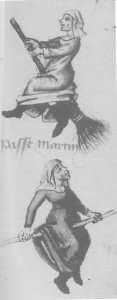
Witches flying on broom and staff. From manuscript border of Martin Le Franc's 1440 Defender of Ladies.
The stereotypic witch is the deluded worshipper of Satan, working her evil in remote congregations she accesses by flying on her broomstick. She has a huge larger-than-life nose with larger-than-life warts, and one of her greatest sins is the fashion mistake of that ridiculous cone hat. She is a misguided dupe who will, of course, meet with a sorry end as the forces of good prevail.Curiously enough, there are parts of this stereotype with a basis in reality. The most interesting of these is the flight on the broom.Broom flight came relatively late in the Christian understanding of witchcraft. Medieval writings such as the 906
Canon Episcopi talk about the idea of pagans shapeshifting into
animals in order to go places and do things, though the texts make clear that the error is not in doing these things but in believing that they happen. A clerical reference to witches on broomsticks appears in 1440 in Martin Le Franc’s
Defender of the Ladies. In this essay Le Franc takes exception to the belief that women are more likely than men to do the Devil’s bidding, arguing that this belief is based on fanstastic assumptions like broom travel. He discusses the confession of a sixteen year old girl at a trial and concludes that “There are no broomsticks or rods by which anyone could fly. But when the devil can fool the mind, they
think they fly….” Again, the error is not in the act of flying, but in believing that flight is possible. Since theology around Satan and witchcraft solidified by the thirteenth century, and witch flight continued to be suspect within this paradigm, it is likely that the idea of witches flying on brooms arose not out of Christian cosmology but pagan belief. Eventually broomstick flying did become stock in the witch hunter’s lore, though witch prosecutors like Matthew Hopkins lamented that the belief cheapened the discipline. The need for prosecutors at actual trials to establish a
modus operandi may explain why the scenario of the witch flying on her broomstick was accepted outside of more erudite theological circles. The scenario explained how the witches (many of whom were elderly) were getting to their sabbats in the wilderness undetected, and it allowed the testimony of victims and witnesses, who often insisted on dragging in broom flight, to be admitted in full.

Aphrodite riding a swan or goose, carrying staff or distaff. By Achilles the Painter, 450 bce. University of Haifa Library.
So how did people get the idea that witches were flying on brooms (or staves or animals)? The simple answer, which we’ll get to eventually, is that they really were flying. Another point to consider is the relationship between the priestess and her goddess. While the monotheistic religions (and many pagan religions as well) place a wide distance between the greatest priest/priestess and the deity, in many pagan religions a priestess can become endowed over time with the qualities of her deity. Christian theologians may have furthered this conflation between goddess and priestess by their emphatic portrayal of goddesses (whom they categorically referred to as “demons”) as the mundane part of their divine/worldly dichotomy. Sometimes in Christianized folklore the goddess even becomes a witch.We know from myth and art that goddesses are always flying around, often with staves, distaffs or brooms, or on the backs of animals. The germanic giantess Hyrrokkin rides on the back of a wolf, and witnesses in a witch trial from Switzerland testified that the accused was seen flying on a wolf. More often the goddess is shown carrying a staff or a distaff as she flies, with or without animal support. While today the broom is the stock image, medieval and Renaissance witches were often portrayed flying on staves or distaffs. The Russian Baba Yaga, who has counterparts throughout Eastern Europe, definitely has a flying broom association. Baba Yaga is described as a witch, but her awesome powers are goddess-like. She rides through the sky at night in a mortar, using the pestle as an oar to steer. With her broom she sweeps the tracks away as she rides. Baba Yaga is an ancient crone with a huge nose almost touching her chin. She or harvest crone goddesses like her probably influenced the broomstick witch stereotype.

Flying witch with distaff on indeterminate animal doing weather magic. From Albrecht Durer's early 16th century engraving Witch Riding. Thought to be inspired by a cameo of Aphrodite Pandemos.
SourcesGuerber, H.A.
The Norsemen. London: Senate, 1994.Johns, Andreas.
Baba Yaga: The Ambiguous Mother and Witch of the Russian Folktale. New York: Peter Lang, 2010.Kors, Alan Charles and Edward Peters, eds.
Witchcraft in Europe 400-1700. Philadelphia, University of Pennsylvania Press, 2001.Still to come:
What if they really were flying?

